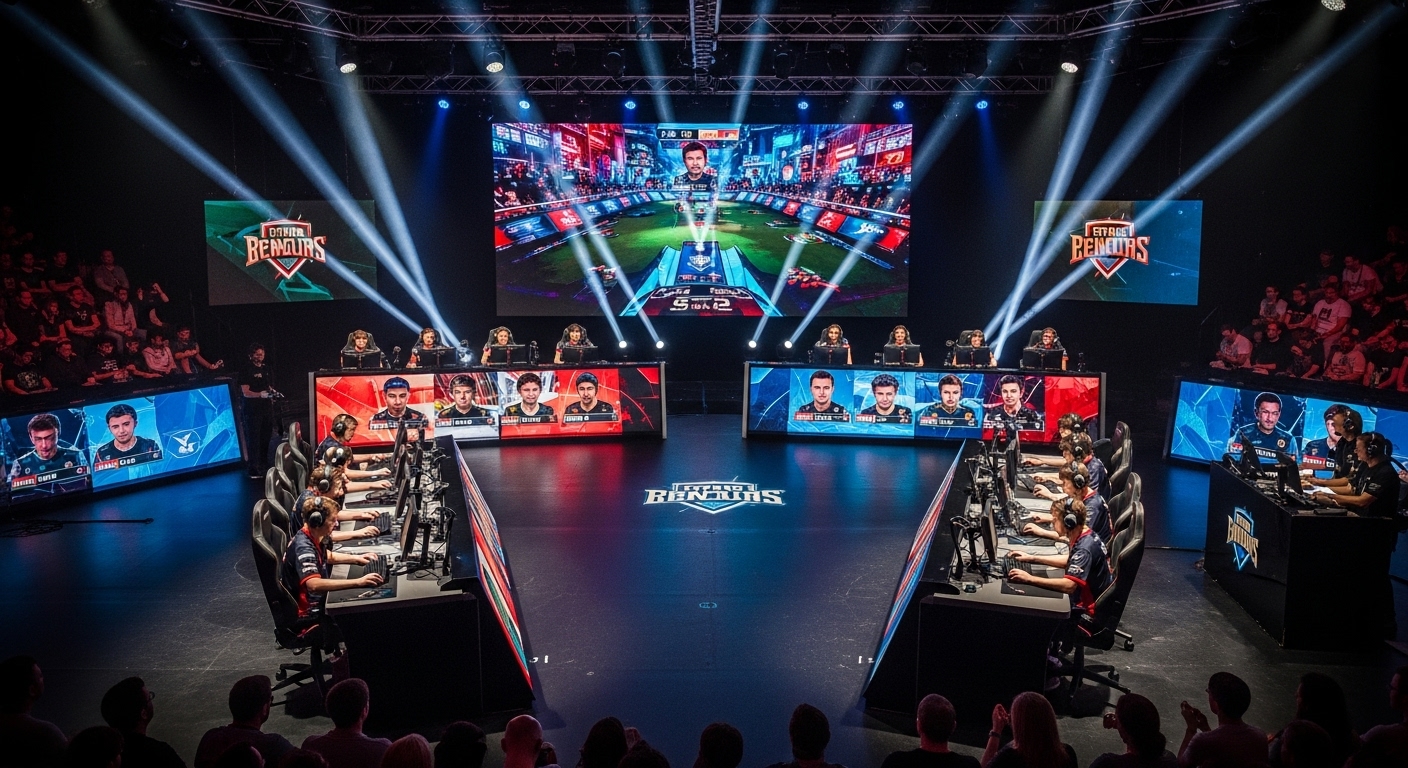Esports has emerged as one of the fastest-growing sectors in the entertainment industry over the last two decades. What once started as a hobby for gamers has now become a massive global phenomenon, influencing everything from digital media to the way sports and entertainment are consumed. Esports today has millions of fans, millions in sponsorships, and is steadily becoming a force that rivals traditional sports in terms of viewership, prestige, and influence. In this blog post, we will delve into the evolution of esports, explore its rapid growth, examine its impact on culture, and discuss the future of this exciting industry.
The Origins of Esports: A Game of Innovation and Competition
The roots of competitive gaming stretch back to the early days of video games in the 1970s and 1980s. The first notable gaming competition, the Space Invaders Championship in 1980, was a breakthrough moment for competitive gaming, with thousands of participants vying for the top prize. Yet, this event was just the tip of the iceberg. The real birth of esports as we understand it today came in the 1990s, fueled by the growing popularity of personal computers and the development of online multiplayer games.
In the early days, competitive gaming was largely localized—taking place in arcades or small LAN (Local Area Network) parties where players competed in games like Quake and StarCraft. These were informal gatherings, with no established prize money or professional infrastructure. However, they marked the beginning of something that would grow into an industry. In 1997, the Red Annihilation tournament for Quake was one of the first true esports competitions, where the winner, Johnathan “Fatal1ty” Wendel, became one of the first professional esports players.
As internet access expanded globally, the first formalized esports tournaments and leagues began to emerge. One of the most significant early developments was the creation of the Cyberathlete Professional League (CPL) in 1997, which hosted tournaments for games like Quake and later Counter-Strike. These tournaments helped establish the foundation for organized esports, providing competitive gamers with a platform to showcase their skills and win substantial cash prizes.
The Growth and Popularization of Esports in the 2000s
By the early 2000s, esports was beginning to take shape as a recognized competitive industry. With games like Counter-Strike, Warcraft III, and StarCraft becoming household names, the scene began to attract larger audiences, and the concept of professional gaming began to take off. It was during this time that South Korea emerged as the epicenter of competitive gaming. StarCraft in particular took the country by storm, and Korean players and teams became internationally recognized as some of the best in the world.
Korean television stations began broadcasting esports tournaments, turning them into mainstream entertainment. Professional esports leagues, such as the Korean Pro-Gaming League (KPGL), began to organize regular competitions, and players became local celebrities. The success of StarCraft laid the foundation for the global esports scene, demonstrating that there was both an audience and a viable financial model for competitive gaming.
In the U.S., the rise of online gaming platforms such as Battle.net by Blizzard Entertainment and Steam by Valve made it easier for gamers to connect with others globally. Games like Warcraft III and Counter-Strike saw a surge in competitive play thanks to these platforms. In 2000, the World Cyber Games (WCG) was established, quickly becoming one of the largest and most prestigious esports events worldwide. It helped spread esports to different parts of the globe, as players from various countries began to compete against one another for global dominance.
Despite these strides, esports was still seen by many as a niche activity with limited mainstream appeal. However, this perception was about to change, thanks to a number of key developments in the following decade.
The Explosion of Esports: 2010 and Beyond
The real turning point for esports came in the early 2010s when the industry saw an exponential rise in both viewership and participation. Several key factors contributed to this growth, chief among them the emergence of streaming platforms and the rise of key esports titles like League of Legends.
In 2011, the launch of Twitch—a live streaming platform dedicated to gaming—became a game-changer for esports. Twitch allowed gamers to broadcast their gameplay to a global audience in real-time, and it quickly became the go-to destination for watching live esports competitions. The platform allowed fans to interact with players, ask questions, and engage in live chat, creating a sense of community around gaming. Twitch‘s popularity grew exponentially, reaching millions of viewers by 2014 and laying the groundwork for esports’ global expansion.
At the same time, games like League of Legends (LoL) from Riot Games became central to the growth of competitive gaming. LoL quickly rose to prominence, offering a combination of strategic depth, fast-paced action, and a strong team-based format that was perfect for esports. Riot Games invested heavily in the development of a robust esports ecosystem, introducing the League of Legends Championship Series (LCS) in 2013, which featured a professional league for North America and Europe. This formalized the competitive scene, creating a sustainable structure for players, coaches, and teams to operate.
The introduction of esports leagues modeled after traditional sports was another crucial development. The creation of the Overwatch League (OWL) in 2018 by Blizzard Entertainment followed the same format as sports leagues like the NBA and NFL, with teams representing cities and regions. This helped bring esports closer to the mainstream, attracting investors, major brands, and even traditional sports teams. The Overwatch League’s franchising model and the high-profile participation of investors in the league made esports more professional, stable, and accessible.
In addition to these gaming titles and leagues, esports saw a massive surge in prize pools. The International, an annual Dota 2 tournament, became particularly noteworthy for its record-breaking prize pools, which reached upwards of $40 million in 2021. This trend helped attract more top players and increased the overall prestige of esports events, drawing in millions of fans globally.
Esports Today: A Multi-Billion Dollar Industry
By 2021, esports had truly cemented itself as a multi-billion-dollar industry. In the years leading up to this point, the esports market had exploded in terms of revenue, sponsorships, and fan engagement. It was estimated that in 2021, the esports industry was valued at around $1.1 billion, with revenue coming from a combination of sponsorship deals, advertising, media rights, ticket sales, and merchandising.
One of the driving forces behind esports’ financial success has been the increased investment from major corporations. Brands like Intel, Coca-Cola, Red Bull, Nike, and BMW have all partnered with esports organizations and tournaments, recognizing the lucrative and young audience that esports attracts. These sponsorships not only provide the funding necessary for esports events but also help increase the visibility of the industry in mainstream media.
The growing popularity of streaming platforms like Twitch and YouTube Gaming has also contributed to esports’ success. In 2021, the League of Legends World Championship reached over 100 million viewers, surpassing the viewership of many traditional sports events. The accessibility of esports content, available on a variety of platforms, has played a significant role in reaching a global audience. Streaming not only helps grow the viewership of live events but also provides a means for players to earn a living through subscriptions, donations, and sponsorships.
Additionally, esports has become a significant driver of technological innovation. Companies are continually developing new hardware, software, and streaming technologies to enhance both the player and viewer experience. From advanced gaming peripherals to high-definition broadcasts, the rise of esports has led to new developments in gaming technology that have filtered into other industries, including entertainment and virtual reality (VR).
The Cultural Impact of Esports: Changing Entertainment Forever
Esports has had a profound impact on global culture, influencing how people perceive gaming, competition, and entertainment. In many ways, esports has shattered stereotypes, transforming the image of the gamer from an isolated individual to a respected professional athlete. Esports athletes—often referred to as “pro gamers”—have gained celebrity status, attracting huge followings on platforms like Twitch, YouTube, and Twitter. These athletes are not just competitors; they are influencers, sponsors, and cultural icons.
The rise of esports has also brought about a new wave of fandom. Just as traditional sports teams have loyal fanbases, esports teams and players have developed dedicated communities that support them both online and offline. Fans participate in social media campaigns, engage with players on streaming platforms, and follow their favorite teams to live tournaments. The sense of community is strong, and it plays a major role in maintaining esports’ global appeal.
Additionally, esports has become a significant part of the education system. Colleges and universities across the world now offer esports programs, providing scholarships and academic opportunities for aspiring gamers. These programs have legitimized esports as a potential career path, and many students pursue degrees in game design, broadcasting, or event management with an eye toward entering the esports industry.
Furthermore, esports has created a bridge between traditional sports and gaming. Many sports teams and athletes have started to invest in esports, understanding the value of connecting with younger, tech-savvy audiences. For example, major traditional sports teams like the Dallas Cowboys and Manchester City have their own esports teams and participate in competitive gaming leagues. This crossover between traditional and esports has helped both industries flourish and has proven that there is a place for esports alongside conventional sports.
The Future of Esports: What’s Next?
As esports continues to grow, there are several key areas that are poised for expansion. One of the most exciting developments is the potential for virtual reality (VR) and augmented reality (AR) in esports. The integration of VR and AR technologies into competitive gaming could create new ways for players and fans to experience esports, making it more immersive and interactive than ever before.
Additionally, mobile esports is on the rise. Games like PUBG Mobile, Free Fire, and Arena of Valor have become some of the most popular esports titles in regions like Southeast Asia and Latin America, where mobile gaming has become the dominant form of gaming. As smartphones become more powerful and mobile internet connectivity improves, mobile esports could continue to grow rapidly, reaching new audiences around the world.
The globalization of esports is another exciting prospect for the future. While esports is already a global phenomenon, there are still many untapped markets, particularly in regions like Africa, India, and Eastern Europe. As these regions develop their own esports ecosystems, we can expect even more international tournaments, talent, and fan engagement.
In conclusion, esports is no longer just a niche hobby for a select group of enthusiasts. It has become a major cultural and financial force, transforming the way we think about gaming, competition, and entertainment. With its rapid growth, increasing sponsorships, and widespread appeal, esports is poised to continue its upward trajectory, shaping the future of digital entertainment and beyond.



